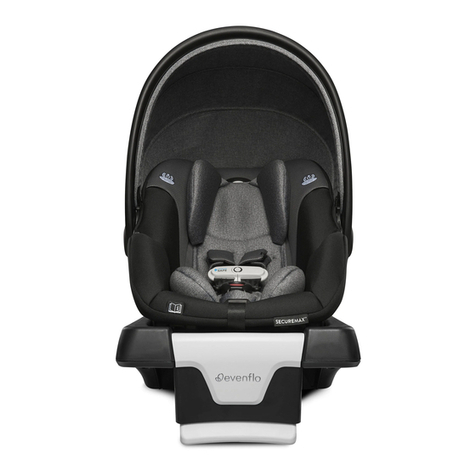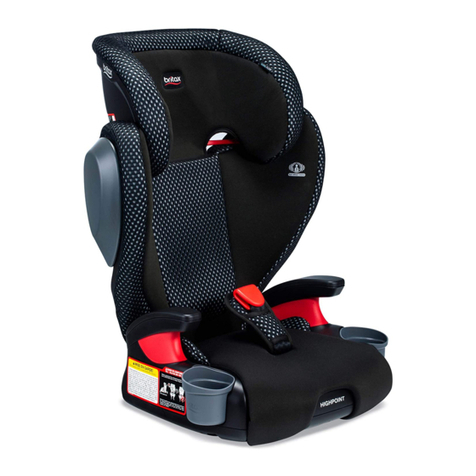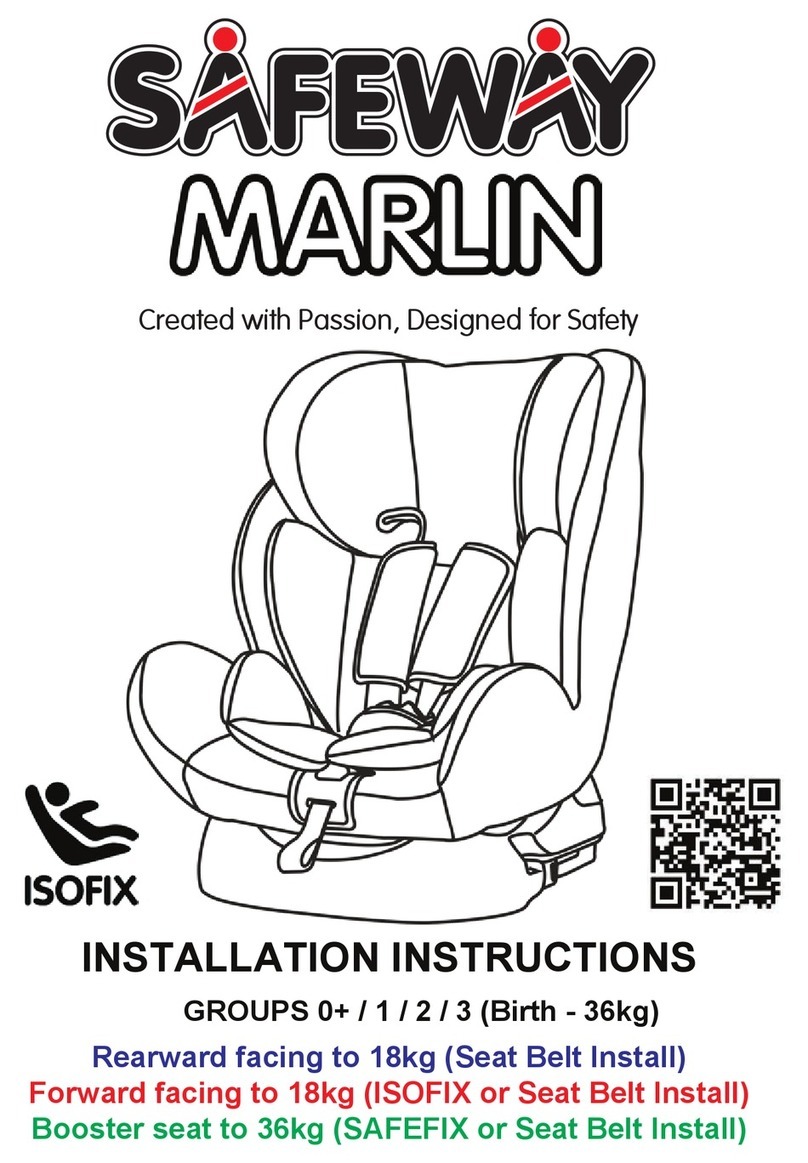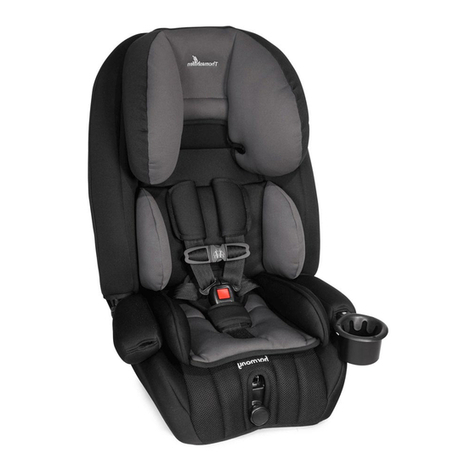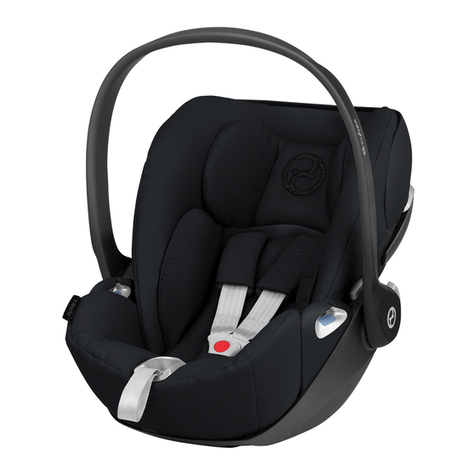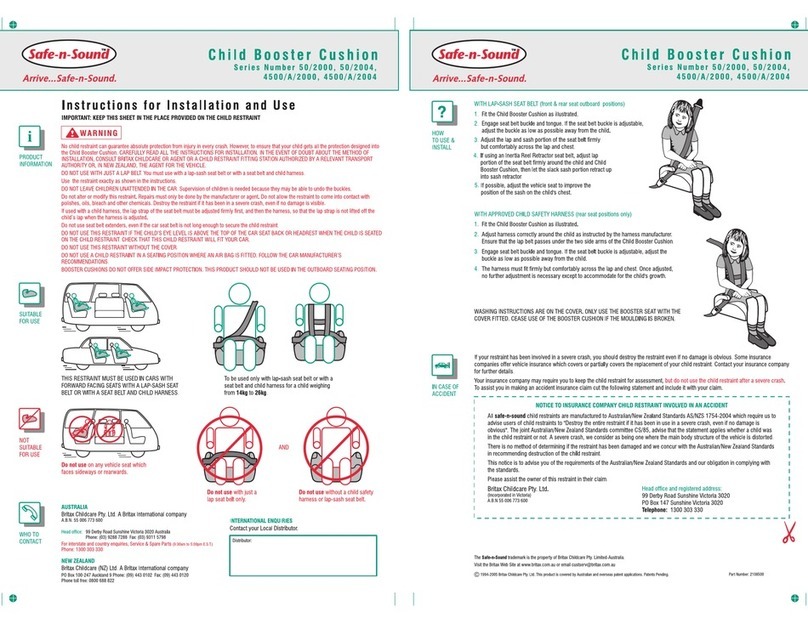Evenflo Gold Revolve 360 User manual

3-in-1 Rotating Car Seat
Owner's Manual
Keep instructions for future use.
© 2020 Eveno Company, Inc. 25701580 10/20
To reduce the risk of serious injury or death,
read this owner’s manual prior to installing
and using this child restraint.
WARNING:
!


According to the U.S. National Highway Trafc Safety Administration
(NHTSA), car seats and boosters provide protection for infants and children
in a crash, yet car crashes are a leading cause of death for children.
To reduce the risk of SERIOUS INJURY or DEATH, read this owner’s manual
and your vehicle owner’s manual before installing and using this child restraint.
Using a child restraint makes a big difference. By properly using this child
restraint and following these instructions, the instructions on the child restraint,
and the instructions that accompany your vehicle, you will greatly reduce the
risk of serious injury or death to your child from a crash. Do not be misled by the
commonly used term “safety seat”; no restraint system can prevent all injuries
in all crashes. Many properly restrained adults and children are injured in motor
vehicle crashes, including relatively minor crashes. A properly used child restraint
is the best way to minimize injuries to your child and to increase the chances for
your child’s survival in most crashes.
FEDERAL STANDARD NO. FMVSS213
Child Restraint Systems
This child restraint conforms to all applicable Federal motor vehicle safety
standards.
CANADIAN REGULATORY NOTICE
(Model numbers ending in “C”)
This child restraint meets all applicable requirements of Canadian Motor
Vehicle Safety Standards CMVSS 213, 213.1, and 213.2.

4
IMPORTANT INFORMATION
Child Requirements ......................................................................................................... 7
Premature Infant Use................................................................................................ 8
Rear-Facing Mode .................................................................................................. 10
Forward-Facing Mode............................................................................................. 12
Booster Mode ......................................................................................................... 14
Warnings........................................................................................................................ 16
Motor Vehicle/Aircraft Usage.......................................................................................... 35
Registration and Recall Information............................................................................... 36
Child Restraint Features ................................................................................................ 38
Seat Rotation.......................................................................................................... 42
Adjustable Buckle Strap.......................................................................................... 44
Height Adjustable Headrest.................................................................................... 45
Cup Holders............................................................................................................ 46
Body Pillow ............................................................................................................. 47
Head Pillow............................................................................................................. 48
Tether Strap ............................................................................................................ 49
Harness Strap Pads and Harness Covers.............................................................. 50
Lower Anchor Connectors ...................................................................................... 51
USING THE CHILD RESTRAINT
Installing and Removing the Child Restraint from the Base........................................... 53
Installing the Child Restraint to the Base................................................................ 53
Removing the Child Restraint from the Base.......................................................... 54
Table of Contents

5
Lap/Shoulder Belt (Rear-Facing and Forward-Facing)................................................... 55
Installing Lap/Shoulder Belt (Preferred Method)..................................................... 55
Removing Lap/Shoulder Belt.................................................................................. 63
Lap Belt Only (Rear-Facing and Forward-Facing).......................................................... 65
Installing Lap Belt ................................................................................................... 65
Removing Lap Belt ................................................................................................. 73
LATCH/UAS (Rear-Facing and Forward-Facing) ........................................................... 75
Installing LATCH/UAS............................................................................................. 75
Removing LATCH/UAS ........................................................................................... 83
Booster Mode (Forward-Facing Only)............................................................................ 85
Converting to Booster Mode ................................................................................... 85
Installing the Booster .............................................................................................. 90
GENERAL INFORMATION
Securing the Child with Harness.................................................................................... 95
Securing the Child in Booster Mode ............................................................................ 103
How is a Booster Seat Used?............................................................................... 103
Securing with the Booster..................................................................................... 104
Removing/Replacing the Seat Cover........................................................................... 105
Care and Cleaning....................................................................................................... 114
Proper Disposal ........................................................................................................... 115
Replacement Parts ...................................................................................................... 116
Recording Model Information and Storing Your Instructions ........................................ 118
Eveno Gold Lifetime Warranty.................................................................................... 119
Table of Contents

6
Symbol Legend
Airbag Symbol Alerts you to important information about airbag
safety.
LATCH/UAS Symbol Alerts you to important information about
LATCH/UAS safety.
Tether Anchor Symbol Alerts you to important information about Tether
Anchor safety.
Aircraft Symbol Alerts you to important information about
aircraft safety.

7
Child Requirements
This child restraint is designed for use by children in both REAR-FACING and
FORWARD-FACING mode, as well as in BOOSTER mode. To use this child
restraint properly, children MUST meet the size and age requirements on the
following pages. In addition, Eveno recommends consulting with your child’s
physician before allowing your child to transition between modes.
The American Academy of Pediatrics (AAP) recommends keeping children
REAR-FACING for as long as possible, until they reach the maximum height
or weight for their child restraint in REAR-FACING orientation.* Additionally,
some states’ laws require children to be REAR-FACING until age 2. Accordingly,
you will see this guidance reected in the Child Requirements on the following
pages. Please review any applicable local, state or provincial laws related to child
passenger safety before installing and using this child restraint.
!WARNING! DEATH or SERIOUS INJURY can occur.
*Pediatrics. 2018;142(4):e20182460

8
Before using this child restraint for preterm or low birth weight infants, ensure
the Child Requirements are met and follow the guidelines in this section.
According to NHTSA, a properly installed child restraint reduces the risk of death
by over 70% for infants involved in crashes. Federal Motor Vehicle Safety Standard
(FMVSS) 213 establishes design and dynamic performance requirements for
child restraint systems. However, the standard has no minimum weight limit and
does not address the special medical needs of preterm or low birth weight infants.
To ensure that preterm and low birth weight infants are transported safely, the
guidelines published by the American Academy of Pediatrics (AAP) in Pediatrics
2009;123:1424–1429 (reafrmed June 2018) must be followed.
Preterm and low birth weight infants are at additional risk of breathing difculties and
heart problems when placed in a child restraint. Eveno requires that the evaluation
recommended by the AAP be conducted for all infants born earlier than 37 weeks
and all newborn infants who weigh less than 2.26 kg (5 lbs) at birth before their
rst car trip to check for breathing difculties or heart rate problems when traveling
in a REAR-FACING child restraint. Newborn infants should NEVER travel in a
FORWARD-FACING
child restraint.
Premature Infant Use
Premature Infant Use

9
Premature Infant Use
The AAP recommends that appropriate hospital staff observe your infant in the
child restraint for a period of 90 to 120 minutes or the duration of travel, whichever
is longer. This period of observation must be performed with the infant properly
positioned as described in these instructions and with the child restraint placed at
an angle that is approved for use in the vehicle. The hospital staff will check for any
breathing difculties or heart rate problems. Your child’s pediatrician will let you know
if there are any special considerations for travel. The number of trips and the duration
of time the infant is seated in the child restraint should be minimized. A caregiver
should ride in the back seat to monitor the infant during travel.
You can learn more about the AAP’s recommendations as well as other resources for
parents and medical professionals, at https://www.healthychildren.org/english/safety-
prevention/on-the-go/Pages/default.aspx.
Premature Infant Use

10
Child Requirements
CHILD REQUIREMENTS
• 1.9 - 18 kg (4 - 40 lbs)
• 44 - 101 cm (17 - 40 in)
• Top of child’s head is at least 2.5 cm (1 in) or more
below the top of the child restraint Headrest or Shell
• Harness straps must be adjusted to be AT or JUST
BELOW child's shoulders.
IMPORTANT: Once your child exceeds any of the size
requirements above, they MUST use this child restraint
in the FORWARD-FACING orientation, if possible.
If your child exceeds any of the size requirements
above and is less than 2 years old, however, you MUST
discontinue use of this child restraint.
Rear-Facing Mode

11
Child Requirements
Rear-Facing Mode
OPTIONAL: To ensure a better t for
smaller infants, the Body Pillow (pg. 47)
and/or Head Pillow (pg. 48) may be used
in REAR-FACING mode ONLY.
1.9 - 9kg (4 - 20 lbs)
Lower Connectors/UAS
Lap/Shoulder Belt Lap Belt
Always use tether strap in rear-facing installation.
Ball must be in proper
zone for child size:
Vehicle MUST be on
level ground.
2580904210/20
9.1 - 18kg (20 - 40 lbs)
Do not installby
this method fora
child weighing
more than
15.9 kg
(35 lbs).
LEVEL INDICATOR
REAR-FACING ONLY
1.9 - 18 kg (4 - 40 lbs)
44 - 101 cm (17 - 40 in)
REAR-FACING
For REAR-FACING installation, Recline
Ball should be in correct zone for child
size:
• White Zone: 1.9 - 9 kg (4 - 20 lbs)
• Black Zone: 9.1 - 18 kg (20 - 40 lbs)

12
Child Requirements
Forward-Facing Mode
CHILD REQUIREMENTS
• 10 - 29.4 kg (22 - 65 lbs)
• 72 - 124 cm (28 - 49 in)
• Tops of the child’s ears are at or below the top of the
child restraint headrest
• At least 2 years old
• Harness straps must be adjusted to be AT or JUST
ABOVE child's shoulders.
IMPORTANT: Once your child exceeds any of the size
requirements for FORWARD-FACING use above, you
MUST discontinue use of this child restraint with its
internal harness and begin using it in BOOSTER mode,
if possible.
If your child exceeds any of the size requirements for
FORWARD-FACING use above and is less than 4
years old, however, you MUST discontinue use of this
child restraint.

13
Child Requirements
Forward-Facing Mode
When used FORWARD-FACING,
make sure the child restraint is in the
UPRIGHT position as shown.

14
Child Requirements
Booster Mode
CHILD REQUIREMENTS
• 18 - 54.4 kg
(40 - 120 lbs)
• 112 - 144 cm
(44 - 57 in)
• Tops of the child’s
ears are at or below
the top of the booster
seat headrest
• At least 4 years old
IMPORTANT: Once your child exceeds
any of the size requirements above
for BOOSTER mode, you MUST
discontinue use of this seat. Your child
may be ready for use of the vehicle belt
system only at this time.

15
Child Requirements
Booster Mode
When to put your child in a Booster
Booster seats raise the child up and help to position the vehicle lap and shoulder
belt correctly. When the child is properly restrained in a booster seat, their risk
of injury in all types of crashes is reduced, as the lap and shoulder belt provide
excellent restraint of the upper and lower torsos.
It is important for the child to sit properly within the vehicle seat belts. When the
vehicle belt is buckled, the lap belt should be low on the hips, just touching the
thighs, and the shoulder belt should lie across the middle of the shoulder. If the
child leans out or moves the belt behind the back or places it under the arm, it will
not provide the intended restraint.
You should consider using a booster seat if the following conditions apply:
• The child is approaching/has exceeded the weight or height limit of their child
restraint's current mode of use. Even children who have not outgrown their child
restraint can benet from the use of a booster seat if it is used properly.
• The child is mature enough to sit in the booster seat and not put the belts under
their arm or behind their back.
• If you have a vehicle that does not have a tether anchorage but has lap/shoulder
belts available in the back seat, a booster seat may provide better protection
than an internal harness seat without the tether.

16
!WARNING! DEATH or SERIOUS INJURY can occur.
Airbag Warnings
• DO NOT place REAR-FACING child seat on front seat with air bag.
• DEATH OR SERIOUS INJURY CAN OCCUR. The back seat is the safest
place for children 12 and under.
• DO NOT use this child restraint in the front seat of a vehicle equipped with an
air bag, unless the air bag has been deactivated. Interaction between a REAR-
FACING restraint and air bags may cause serious injury or death. Air bags may
cause serious injury or death to children 12 years of age and under. If your
vehicle has an air bag, refer to your vehicle owner’s manual for child restraint
installation.
• DO NOT place any objects between the restraint and the side air bag, as an
expanding air bag may cause the items to strike your child.

17
!WARNING! DEATH or SERIOUS INJURY can occur.
• If the rear seat of your vehicle is equipped with side air bags, refer to the
following information for proper usage:
Vehicles built prior to the 2002 model year:
DO NOT use this restraint in a vehicle seating position equipped with a side air
bag unless authorized by the vehicle manufacturer.
Model year 2002 and newer vehicles:
Refer to your vehicle owner’s manual before placing this restraint in a seating
position equipped with a side air bag.
Airbag Warnings
The FORWARD-FACING back seat is the safest place
for children 12 and under.

18
!WARNING! DEATH or SERIOUS INJURY can occur.
General Warnings
• Failure to follow the REAR-FACING, FORWARD-FACING and BOOSTER
Child Usage Requirements for this child restraint could result in serious injury
or death. (See "Child Requirements" on pgs. 10 - 15).
• Failure to follow installation instructions and the instructions and warning labels
on product can result in the child striking the vehicle’s interior during a sudden
stop or crash. Serious injury or death may result. These instructions and the
instructions in your vehicle owner’s manual must be followed carefully. If there is
a conict between the two, the vehicle owner’s manual regarding child restraint
installation must be followed.
• Children have STRANGLED in loose or partially buckled harness straps.
• NEVER leave child unattended.
• DO NOT use child restraint if it is damaged, broken, or missing parts.
• DO NOT use this restraint if it has been involved in a crash. It must be replaced.
• NEVER use the Child Restraint Shell without the Base or the Base without the
Shell.

19
!WARNING! DEATH or SERIOUS INJURY can occur.
Location Warnings
• ALWAYS read and follow exactly the instructions that accompany your vehicle
and child restraint.
• According to accident statistics, children are safer when properly restrained
in the rear seating positions than in the front seating positions. Generally, the
center rear position is safest and should be used if available.
• Some child restraints do not t all vehicles or all seating locations. There are
many thousands of combinations of vehicle makes, models, child restraint
congurations, vehicle seat belt designs, and seat cushion shapes. The
easiest way to determine whether your child restraint is suitable for a particular
seating position is to check for a tight installation. If the child restraint cannot
be properly installed, DO NOT use the child restraint. Consult vehicle owner’s
manual, try a different seating location, or call Eveno for further assistance.

20
!WARNING! DEATH or SERIOUS INJURY can occur.
Location Warnings
• ONLY use this child restraint on FORWARD-FACING vehicle seats. DO NOT
use this restraint with vehicle seats that face the rear or side.
• ONLY use this child restraint on vehicle seats with backs that lock into place.
• VEHICLE TYPES IN WHICH THE RESTRAINT SYSTEM CANNOT BE USED:
This child restraint is not to be used in vehicles that do not have vehicle seat
belts or LATCH/UAS lower anchorages.
• NEVER use this child restraint on boats, low speed vehicles (LSV), all-terrain
vehicles (ATV), golf carts, or any other non-certied application.
Table of contents
Other Evenflo Gold Car Seat manuals
